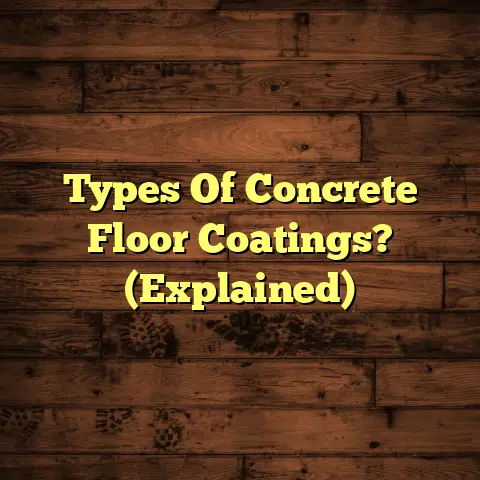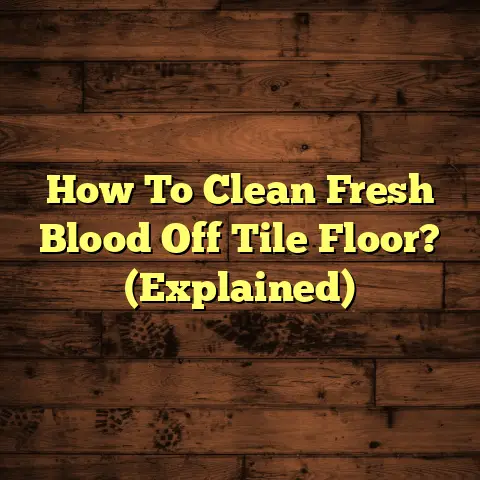How To Get Old Wax Off Hardwood Floors? (Explained)
Have you ever walked into a room and felt that something was off about the hardwood floors?
Perhaps they seemed dull or sticky, and upon closer inspection, you realized that old wax was to blame.
I remember my first encounter with wax buildup on hardwood floors; it was a frustrating experience that taught me valuable lessons about maintenance and restoration.
Understanding Wax Buildup on Hardwood Floors
Old wax can accumulate on hardwood floors over time, leading to a cloudy appearance and a sticky texture.
This buildup can occur from repeated applications of wax products without proper removal, dust, dirt, and grime settling in the wax layers.
To effectively get rid of this unwanted wax and restore the beauty of your hardwood floors, it’s essential to understand the right approach.
What Is Hardwood Floor Wax?
Before diving into the removal process, it’s crucial to understand what hardwood floor wax is.
Wax serves as a protective layer for wood floors, enhancing their shine and helping to guard against scratches and moisture.
There are primarily two types of wax used on hardwood floors:
- Natural Wax: Derived from natural sources like beeswax and carnauba, this type is often favored for its eco-friendliness.
- Synthetic Wax: Manufactured from petroleum products, synthetic waxes are more durable but may contain chemicals that can be harmful if not applied correctly.
The choice between natural and synthetic wax often depends on the desired finish and maintenance routine of the floors.
My Experience with Removing Old Wax
In one of my recent projects, I tackled a home in a historic neighborhood where the owners had neglected their hardwood floors for years.
The living room floor looked beautiful originally but had layers of yellowing wax that dulled its shine.
To address this, I needed to devise a plan that included both effective removal methods and the right tools.
Preparation and Tools Needed
Before starting the project, I gathered my supplies:
- Wax Remover: I opted for a commercial wax remover specifically designed for hardwood floors.
- DIY Solution: I also prepared a mixture of vinegar and water (1:1 ratio) for lighter areas.
- Bucket: For mixing solutions and rinsing.
- Soft Rags or Microfiber Cloths: Essential for applying solutions and drying.
- Floor Buffer: Using a buffer would save time and effort on larger areas.
- Scraper: For any stubborn spots where the wax clung tightly.
I estimated that this project would take about four hours, including prep and cleanup.
The total cost for materials was around $30.
Step-by-Step Process to Remove Old Wax
1. Assess the Floor
First, I inspected the floor closely.
I noticed that certain areas had more buildup than others, particularly around furniture.
This assessment helped me plan where to focus my efforts.
The owners had mentioned they were unsure of the last time the floors were properly maintained or stripped.
2. Choose Your Method
I decided to try both a commercial wax remover and a DIY solution of vinegar and water.
In my experience, commercial products tend to be more effective for heavy buildups, while vinegar is suitable for lighter residue.
The commercial product claimed to dissolve wax effectively within minutes, which piqued my interest.
3. Application
For the commercial wax remover, I followed the instructions: applying it generously with a soft cloth and letting it sit for a few minutes.
I noticed that the product had a strong smell but was assured by the manufacturer that it was safe for use on hardwood.
For the vinegar solution, I dampened a cloth with the mixture and wiped it over the surface.
This method was less invasive but required more elbow grease.
4. Scrubbing
Using a non-abrasive pad, I gently scrubbed the floor in sections.
This part was somewhat labor-intensive, as I focused on areas with more wax.
The buffer came in handy for large areas, cutting down on manual effort.
I found that working in small sections was beneficial; it allowed me to monitor progress closely.
5. Rinse and Dry
After removing the wax, I rinsed the floor with clean water to eliminate any residue from the remover or vinegar.
Then, I dried it thoroughly with clean towels to prevent water damage.
Successes and Challenges
The project went smoothly overall.
The vinegar method worked well on lighter areas, but I found that the commercial remover was necessary for stubborn spots.
One challenge I faced was ensuring that the floor dried completely before applying any new finish; otherwise, it could lead to more issues down the line.
In-Depth Analysis of Methods Used
In my experience with this project and previous ones, I’ve come to realize that different methods suit different situations.
Let’s break down some options:
Commercial Wax Removers
Advantages:
- Speed: Often dissolves wax quickly.
- Effectiveness: Can handle multiple layers of buildup without excessive scrubbing.
Disadvantages:
- Cost: More expensive than DIY solutions.
- Chemicals: May contain harsh chemicals; proper ventilation is necessary.
DIY Solutions (e.g., Vinegar)
Advantages:
- Cost-Effective: Common household items are used.
- Eco-Friendly: Natural ingredients reduce chemical exposure.
Disadvantages:
- Time-Consuming: May require more scrubbing.
- Less Effective: Not always sufficient for heavy buildups.
Helpful Tips Based on My Experience
- Test First: Always test your chosen method in a small inconspicuous area before applying it to the entire floor.
- Be Patient: Removing old wax can take time, especially if there are multiple layers.
- Use Quality Products: Investing in a good wax remover can save you time and effort in the long run.
- Regular Maintenance: To prevent future buildup, establish a regular cleaning schedule using a pH-neutral cleaner designed for hardwood floors.
Maintenance After Wax Removal
Once you’ve successfully removed the old wax, maintaining your hardwood floors is crucial to preserve their beauty and longevity.
Here are some steps you can follow:
1. Choose the Right Finish
After stripping off old wax, consider applying a new finish suitable for your hardwood type—oil-based polyurethane provides durability while water-based options are easier to clean up.
2. Regular Cleaning
Establish a cleaning schedule based on traffic levels in your home:
- Daily or Weekly: Sweep or vacuum to remove dust and debris.
- Monthly: Damp mop with a pH-neutral cleaner.
- Annually: Consider reapplying finish or polish as needed.
3. Avoid Wax Products
Once you’ve removed all old wax, it’s best to avoid using wax-based products moving forward unless you’re prepared for periodic removal again.
Real-Life Application of FloorTally
Throughout this project, I utilized FloorTally to help manage various aspects efficiently:
- Cost Estimates: The platform provided accurate local material costs for cleaners and finishes.
- Project Planning: I inputted the areas needing attention to ensure no spots were overlooked.
- Visual Aids: FloorTally allowed me to showcase options for finishes to the clients visually, helping them make informed decisions on what they wanted post-wax removal.
The comprehensive approach offered by FloorTally saved me hours of calculating budgets manually and allowed me to focus more on hands-on work rather than logistics.
Common Misconceptions About Wax Removal
There are several myths surrounding hardwood floor care that can lead homeowners astray:
- All Wax is Bad: While excessive wax buildup is problematic, a thin layer can protect floors.
- Water is Always Harmful: Water isn’t inherently damaging; it’s prolonged exposure that can cause issues.
- Any Cleaner Works: Using inappropriate cleaners can damage finishes; always check compatibility with hardwood.
Conclusion
Removing old wax from hardwood floors can be a straightforward process if you approach it methodically.
By understanding the materials involved and choosing the right methods— like those offered by FloorTally for planning and budgeting—I was able to restore those beautiful floors successfully.
While challenges may arise during the process, such as stubborn build-up or needing multiple methods to achieve desired results, the end result is always worth the effort.
If you find yourself facing this task, remember that with patience and the right tools, your hardwood floors can shine once again.





